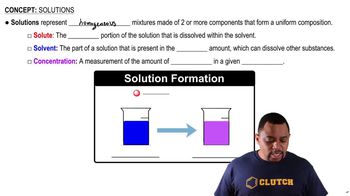This portion of a phase diagram shows the vapor–pressure curves of a volatile solvent and of a solution of that solvent containing a nonvolatile solute. (b) What are the normal boiling points of the solvent and the solution? [Section 13.5]
Indicate whether each statement is true or false: (a) A solute will dissolve in a solvent if solute–solute interactions are weaker than solute–solvent interactions. (b) In making a solution, the enthalpy of mixing is always a positive number. (c) An increase in entropy favors mixing.
 Verified step by step guidance
Verified step by step guidanceKey Concepts
Solute-Solvent Interactions

Enthalpy of Mixing

Entropy and Mixing

Suppose you had a balloon made of some highly flexible semipermeable membrane. The balloon is filled completely with a 0.2 M solution of some solute and is submerged in a 0.1 M solution of the same solute:
Initially, the volume of solution in the balloon is 0.25 L. Assuming the volume outside the semipermeable membrane is large, as the illustration shows, what would you expect for the solution volume inside the balloon once the system has come to equilibrium through osmosis? [Section 13.5]
The diagrams shown represent an emulsion, a true solution, and a liquid crystal. The colored balls represent different liquid molecules. Which diagram corresponds to which type of mixture? [Section 13.6]
Indicate the type of solute–solvent interaction that should be most important in each of the following solutions: a. CCl4 in benzene (C6H6),
Indicate the type of solute–solvent interaction that should be most important in each of the following solutions: b. methanol (CH3OH) in water,
